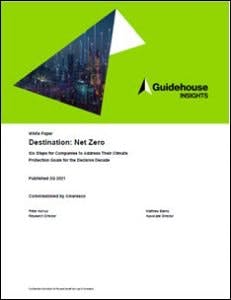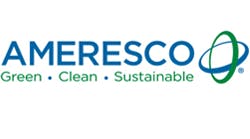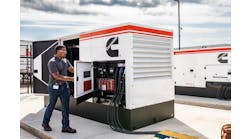Incentives and implementation: How policy informs the clean energy transition
Three major areas are key to meeting our country’s clean energy goals: technology, finance and policy. The three are interdependent and inform one another, but the linchpin for all of them is policy. Strong, consistent clean energy policy creates the supportive environment that is necessary to spur technology and finance innovation.
While the pace of clean energy deployment is accelerating, it has been hampered by inconsistent policies and the lack of policy certainty. But new developments, including incentives for microgrids, could change the course of clean energy policy in the US.
The importance of tax credits
The recently passed Inflation Reduction Act of 2022 (IRA) is the most timely and pertinent policy available to accelerate the clean energy transition. Prior to the IRA being signed into law, the US was only expected to reduce greenhouse gas emissions 17%-25% by 2030, according to the Rhodium Group. A recent Princeton-led study estimates that the IRA could lead to a 42% emissions reduction in that same time frame.
The IRA promotes the clean energy transformation in large part by expanding and providing policy certainty for tax credits, which are one of the main incentives for clean energy in the US. The Investment Tax Credit (ITC) was previously scheduled to phase down, and prior extensions were typically made for only short time windows. The IRA reverses this trajectory, providing 10 years of tax credit certainty at the original ITC rate of 30%. Various adders can even increase the ITC to as much as 70% depending on the project location and whether it uses domestic content.
The IRA extends the ITC to, for the first time, cover stand-alone energy storage and microgrid controllers. By some estimates, changes like these could result in microgrid costs decreasing by 10%-50%. The legislation also extends the production tax credit (PTC) and expands its eligibility to once again include solar projects, creating a potentially lucrative opportunity for the solar industry.
After 2024, the IRA expands the ITC and PTC to apply to any zero-emissions electricity production. This should allow more companies to adopt a technology-agnostic approach. This approach has served Ameresco, as an independent provider, well in designing systems to meet our customers’ needs. Being able to use whatever clean energy technology — such as microgrids, storage, solar and biogas — allows developers to be nimble and flexible in the face of changing economics, customer needs and policies.
A major missed opportunity in the IRA is its lack of a 100% direct pay option, a mechanism that allows an entity to claim a tax credit as a rebate, which would have streamlined project deployment and opened up the incentive to many more entities by allowing the tax credit to be claimed as a rebate. However, a limited version of direct pay has been added for tax-exempt entities such as state and local governments, public schools and universities, tribes and rural electric cooperatives, providing them a new tool to fund clean energy projects. The IRA also allows an entity with a limited tax liability to transfer the value of the tax credit to a corporate partner who can monetize the credit, expanding the universe of potential funding partners that companies like Ameresco can work with.
Equity and the role of microgrids
The IRA includes provisions to support underserved communities, which are disproportionately affected by climate change. As one example, the law should spur solar project development in underserved communities by providing a 20% bonus tax credit for solar projects on federally subsidized affordable housing projects and a 10% bonus credit for solar projects in low-income communities.
Additionally, the IRA authorizes billions in new federal spending to help reduce emissions and improve resilience in these areas. This includes $27 billion for a new Greenhouse Gas Reduction Fund that can help deploy distributed technologies like microgrids in low-income communities, $3 billion for Environmental Justice Block Grants to support climate resiliency and adaptation, $37 million to reduce air pollution in schools, and $235 million for tribal climate resilience.
Get this Guidehouse report on 6 Steps Companies Can Take to Reach Net Zero
The legislation will also support energy equity by helping to unleash microgrid deployment, building on programs already in place such as FEMA’s Building Resilient Infrastructure and Communities (BRIC) program. BRIC has been supporting the development of microgrids to increase resilience for states, local communities and tribes. The IRA encourages more of this work by providing FEMA incentives to develop more low-carbon and net-zero energy projects via its disaster recovery programs.
Microgrids at community centers have already demonstrated their usefulness in powering emergency shelters, cooling centers and places to charge mobile devices. Deploying microgrids in low-income communities is one way of increasing those communities’ access to the benefits of local clean energy.
Microgrids are also expected to play a huge role in infrastructure stability. This is exemplified by projects like the Parris Island Military Microgrid in South Carolina’s Hurricane Alley, an area prone to power outages. To ensure that this mission-critical Department of Defense facility could remain online in the case of a 14-day outage, Ameresco helped the facility install a microgrid. Across the US, whether for military operations or hospitals, microgrids are expected to play an increasingly significant role in ensuring a stable power system to support resilience needs.
Implementing and supporting clean energy policy
While focus in recent months has been on federal legislation, policy at the state and local level always remains critical. States like California, Illinois, Massachusetts, New York and Hawaii have been setting aggressive clean energy policy standards, driving progress and complementing action at the federal level.
If the IRA does get the US to around 40% emissions reductions by 2030, as projected, we’ll still be 10 percentage points short of the 50% reduction needed to comply with our Paris climate agreement target. With entrepreneurial efforts and supportive policies, states and the private sector can help us close that 10% gap. Companies like Ameresco will play a key role by deploying private-sector finance to build more projects.
While financing should be easier with the new federal policy, other obstacles remain that could slow clean energy deployment. Currently, the US has a significant backlog of clean energy projects, which can get stuck in interconnection queues for years. The IRA provides some ability to include interconnection costs as part of the Investment Tax Credit. This is helpful, but we still need to clear out existing backlogs and get projects online as quickly as possible, especially given that the queues could grow exponentially with the new projects that will be spurred by the IRA.
One ongoing issue will be ensuring that state, regional and federal agencies have the staff in place to conduct interconnection studies and permit the many new projects that will be coming across their desks. The IRA includes some funding to help address this; additional investments will also be needed. In addition to the challenges of staffing agencies, adequately staffing the solar and energy storage workforce that the IRA will finance is going to be a serious challenge.
Staffing is also an issue at the more local level. An energy manager for a school district, for example, has to focus on keeping the facility running and may not have the staff to aggressively pursue clean energy projects. As the IRA opens the floodgates to many more projects, companies like Ameresco can serve as staff multipliers to help get projects done.
This kind of customer focus also turns out to be key in supporting strong energy policy. If Ameresco helps a customer become more efficient, save money and gain resilience, that customer often becomes our greatest spokesperson. They are then more likely to influence their legislators to support good policies, even in regions that haven’t embraced clean technology historically. We’ve seen this become a virtuous cycle, in which positive projects create more positive support for these policies.
We must all continue working at the federal, state and local levels to push the industry forward and create a positive policy environment. Working together and with groups like Think Microgrid, the American Clean Power Association and the Solar Energy Industries Association, we can help drive the policies that will unleash the clean energy deployment we need to meet our climate goals.
Mark Fowler is the director of government relations at Ameresco. Get this Guidehouse report on 6 Steps Companies Can Take to Address Climate Goals.









